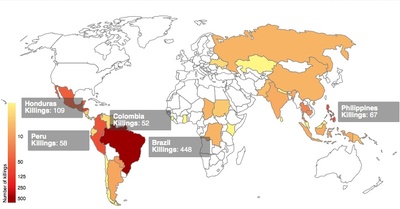
Hundreds of Environmental Activists Murdered

In the past, some have painted environmentalism as a concern of the First World. However, this has never really been true, as it is the most oppressed people who have suffered and struggled against the most extreme man-made disasters. And the threat that their struggles pose to the capitalists’ interests is highlighted by this list of assassinations; people who were mostly killed in cold blood, a fate those in the oppressor nations know nothing about.
There is a concentration of murders in the tropical countries, where vast rain forests with some of the greatest biodiversity on the planet are making what could be their final stand. Long a source of natural resources, in recent decades these forests have been leveled at an increasing rate that cannot be sustained. In such cases there is a clear connection between protecting the ecological functioning of a region and the national liberation struggle tied to land. These “untamed” lands are often the homes of peoples who have not fully been assimilated into the global capitalist economy. Often private property and land deeds do not exist in these areas, attracting the brutality of the exploiters. The people struggling to exist on these lands have a completely different perspective on what land ownership and stewardship mean.
Many of the reports of these assassinations can be discouraging, when we see vocal leaders of small indigenous groups gunned down by paid assassins of the capitalists and no one is held accountable. But this war does have two sides. In many of the hotspots in this report there are strong organizations that have mobilized indigenous people to defend their lands. One of those examples has made some headlines recently in the Philippines. The revolutionary forces in the Philippines have called for a ban on logging because it has impoverished the indigenous people and peasantry, making them susceptible to environmental disasters as we saw last November with typhoon Yolanda. The New People’s Army (NPA) is exerting dual power in putting this ban into effect by engaging in gun battles and arresting members of the military of the U.$. puppet regime that defend the logging companies.(2) In a separate campaign the NPA recently stormed Apex Mining Company, torching their equipment.(3) This is one of many mining companies they have targeted due to the destruction they wreak on indigenous lands and humyn health. This connection between the struggles of the indigenous people and peasantry, the environment and land is nothing new for the Communist Party of the Philippines as was documented in the decades old film Green Guerrillas.
While most pronounced in the Third World, ecological destruction threatens all humyn life and continues to be a growing rallying point for progressive forces in the First World as well. Maoists must tie this work to a realistic class analysis and link the struggle to protect our environment to the struggle for national liberation of the oppressed. A true revolutionary ecology must engage the workings of a system that has assassinated well over 900 innocent people for trying to protect the world that we all live in.
Related Articles:








